CyberSPL: A Framework for the Verification of Cybersecurity Policy Compliance of System Configurations Using Software Product Lines
Abstract
1. Introduction
- OBJ1. Provide users with a set of tools for the definition and the maintenance of a catalogue of cybersecurity policies based on feature models. These policies are associated with different contexts of software products and systems related to cybersecurity.
- OBJ2. Provide users with a set of tools to obtain properties of feature models. For example, a property could be the verification of the correctness of the model, that is, to know the conformance between the products and the model. Another example could be the extraction of all configurations of products or systems supported by the cybersecurity policy.
- OBJ3. Automate the detection of configuration failures to validate with cybersecurity policies through the description of features of the different cybersecurity contexts.
- OBJ4. Provide the diagnosis of the established configurations to isolate and identify the configuration mistakes that cause the non-conformance of the cybersecurity policies.
- OBJ5. Validate the proposal through complex use cases. Such as the configuration of cybersecurity mechanisms of a web application server.
2. Related Work
2.1. Analysis and Diagnosis of Feature Models
2.2. Cybersecurity and Software Product Lines
2.3. Analysis and Verification of Cybersecurity Configurations
2.4. Software Product Line Tools
3. Background in Feature Models and Validation Mechanisms
- Mandatory, child feature is required. (cf. in the figure, PS2 is mandatory sub-feature of A, PS2 ↔ A).
- Optional, child feature is optional (cf. in the figure, PS2 optional sub-feature of B, PS2 → B).
- Alternative, one of the sub-features must be selected (i.e., in general alternative sub-feature of b, ).
- Or-relation, at least one of the sub-features must be selected (i.e., in general or sub-feature of b, , in the figure ).
- Require relation, a feature requires the existence of other features with non-direct family relation (cf., in the figure A2 → C1).
- Exclude relation, a feature excludes the existence of other features with non-direct family relation (cf. in the figure, ¬(D ∧ E))
4. CyberSPL: Cybersecurity Software Product Line
4.1. CyberSPL Workflow and Operation
- There is a selection of security contexts (cf., Define SPL context) according to this cybersecurity policy. In this stage, the organisation has to do an effort on the analysis of the enterprise architecture, thus, to identify the assets and the security control in all the stages of every enterprise layer. Afterwards, the organisation should delimit the scope, the context, by identifying the ecosystems to take into account for the application of the cybersecurity policy.
- Input: Cybersecurity policy, Assets.
- Output: Cybersecurity Context.
- Specification: Analysis of the resources, processes, systems, security controls, and the cybersecurity policy conditions.
- Stakeholders: Operate and Maintain (OM), Protect and Defend (PR), Investigate (IN), and Analyse (AN).
- Once the context is delimited, feature models are selected (cf., Select/Build feature models), if any in the catalogue or constructed. Thus, CyberSPL provides a set of public or private repository of models that can be useful for the analysis of the systems in the selected context. The organisation, through product managers, just should select or define the feature models needed.
- Input: Cybersecurity Context, Feature Model Catalogue.
- Output: Feature models.
- Specification: Selection of feature models or definition of feature models that describe the context.
- Stakeholders: Securely Provision (SP).
- A customisation of the features, attributes and constrains are set (cf., update features, attributes and constraints). The selected or defined feature models must be fully updated with the latest details of the cybersecurity policy established by the organisation. In this case, product managers must adjust certain parameters into the models regarding the subsequent analysis. The adjustments generate new versions of the models that are stored.
- Input: Feature Models.
- Output: Refined feature models store in the catalogue.
- Specification: Include, delete, modify, and update into the models. Thus, update and readjust feature models.
- Stakeholders: Securely Provision (SP).
- Once the models are adjusted, the organisation is able to analyse the context and possible configurations (cf., Analysis Feature Models). Thus, the organisation can apply different operations: (1) validate the models, thus, validate the context of the organisation; (2) determine the number of possible configurations in the context; (3) determine and export all the possible configurations in the context; (4) validate certain configuration product or service according to the established models that describe the context; (5) diagnose certain configuration with regard a context.
- Input: Refined feature models.
- Output: Depending on the operation different output is obtained: a Boolean value which represents the validation of the model, a Boolean value which represents the validation of a configuration model, a number when the number of configurations is required, etc.
- Specification: Validation model, Valid a configuration, Diagnose configuration, Number of configurations, determine all the configurations.
- Stakeholders: Securely Provision (SP).
4.2. CyberSPL Implementation
5. Evaluation Approach
5.1. Context Description and Feature Models
5.2. Analysis of Feature Models and Diagnosis of Configurations
5.3. Discussion of Results
- For Business and security managers, CyberSPL enables improving the task of verification and analysis of cybersecurity policies due to the automatic analysis. Moreover, the use of catalogues and historical records of models enables doing a more flexible, effective, adaptable, and easy-to-maintain security contexts for organisations. The models can be shared and reused in multiple scenarios according to the necessity of the organisations. For instance, the models can be customised and enriched with attributes to indicate which risk level certain features have according to the organisation expectancy.
- For Business and security provisioners, CyberSPL enables automatically verifying and diagnosing whether the configurations comply with established policies and contexts. Moreover, CyberSPL can be useful to obtain valid blueprints to secure and configure products or systems according to the organisation policies.
6. Conclusions and Future Work
Author Contributions
Funding
Acknowledgments
Conflicts of Interest
Appendix A
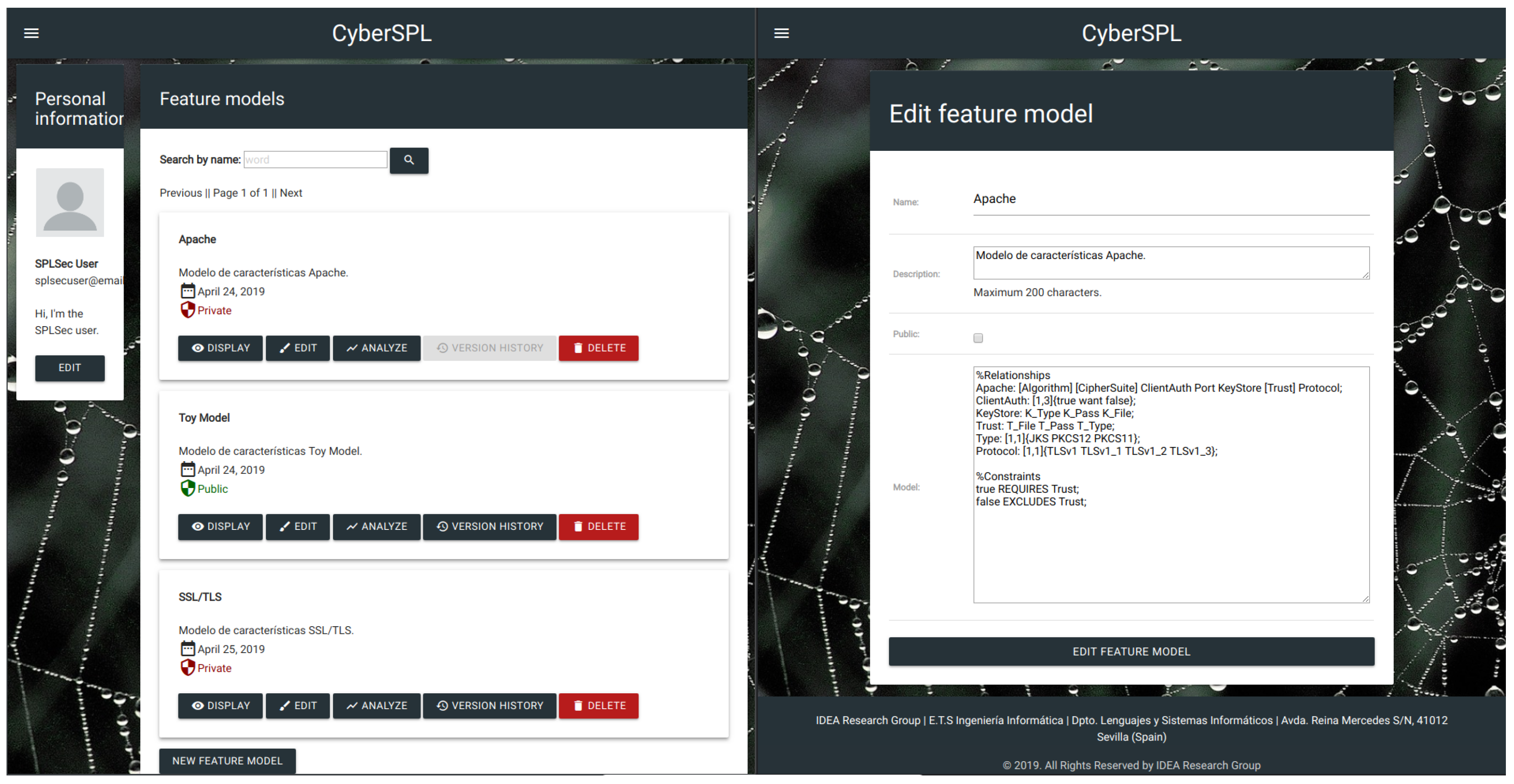
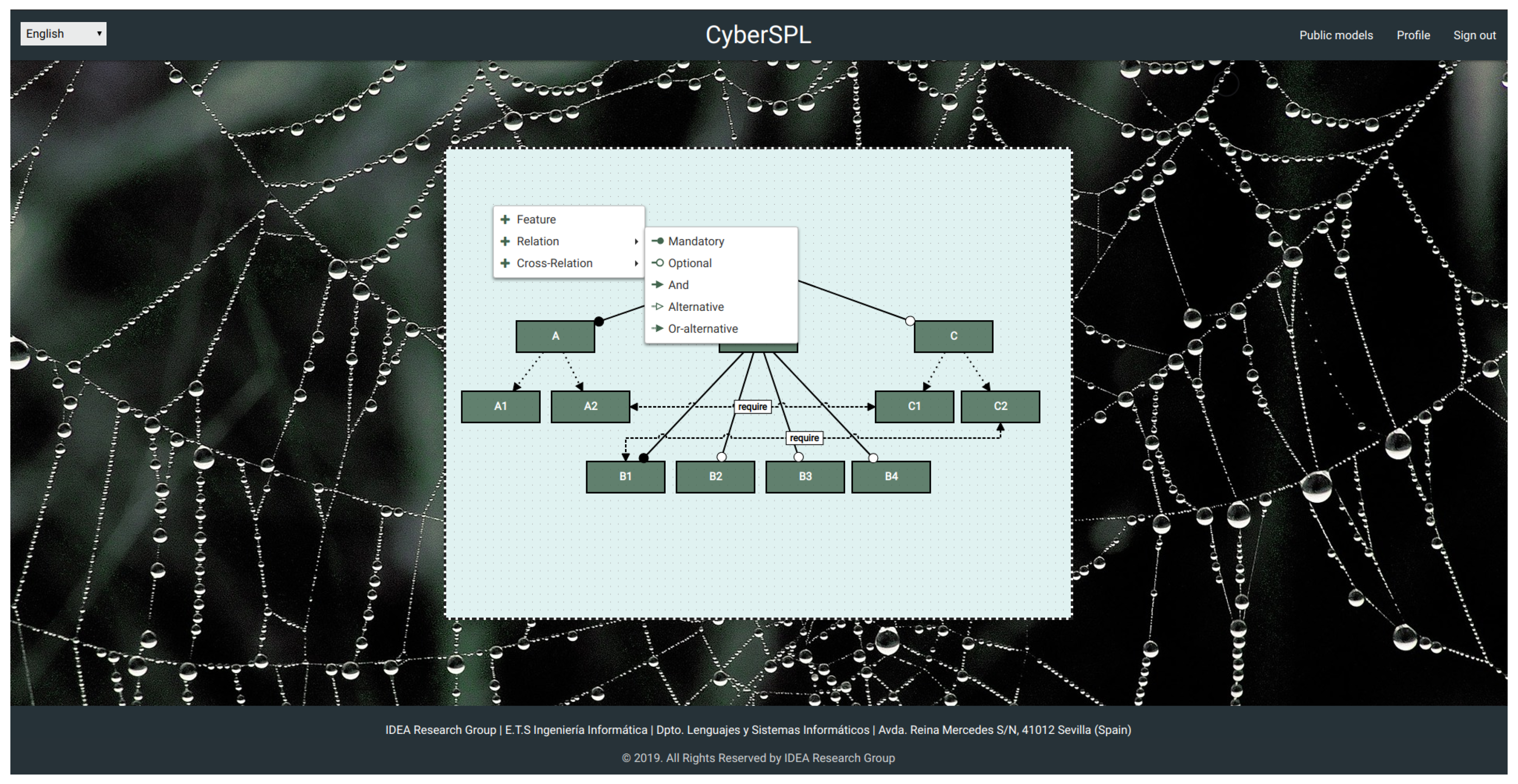
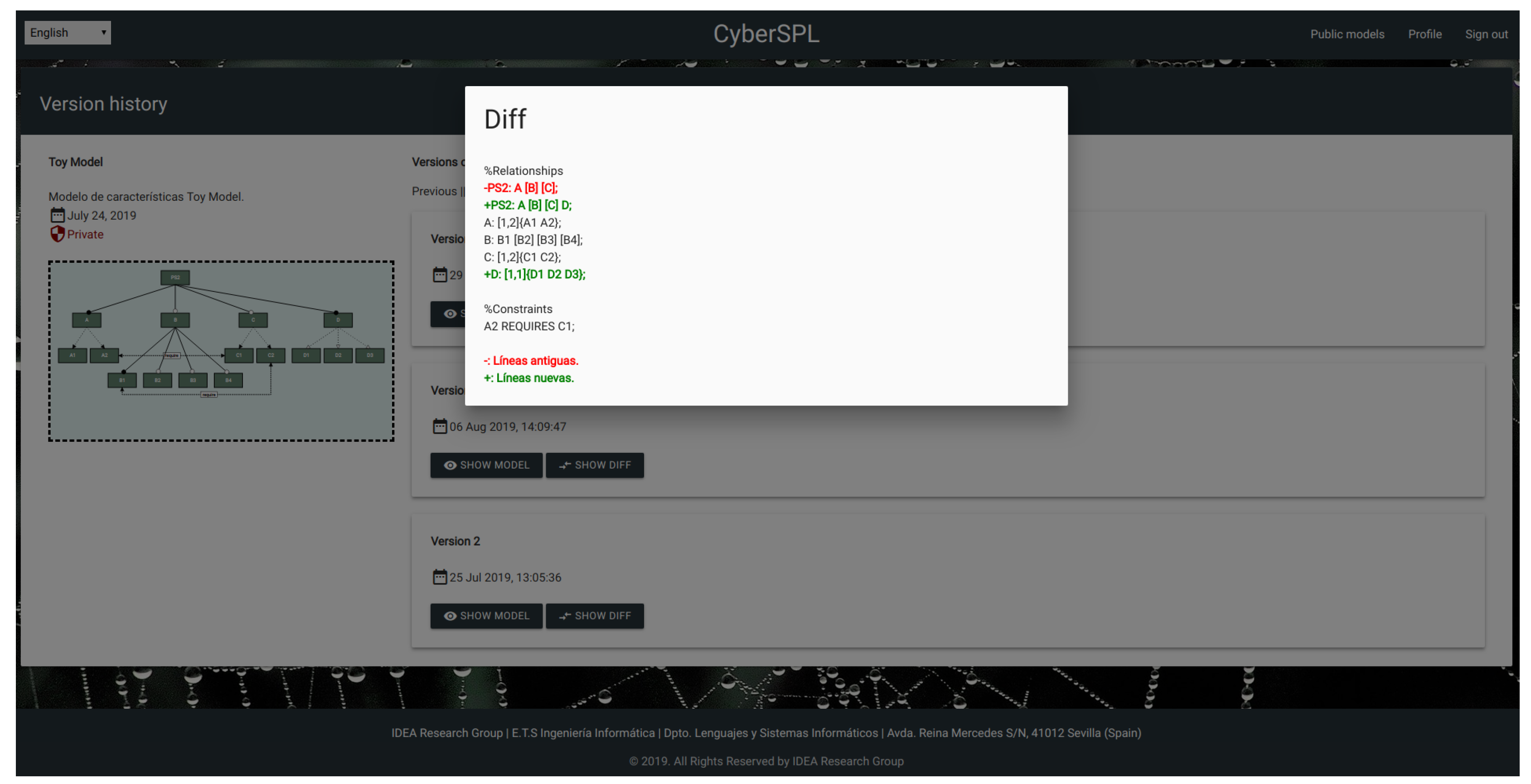
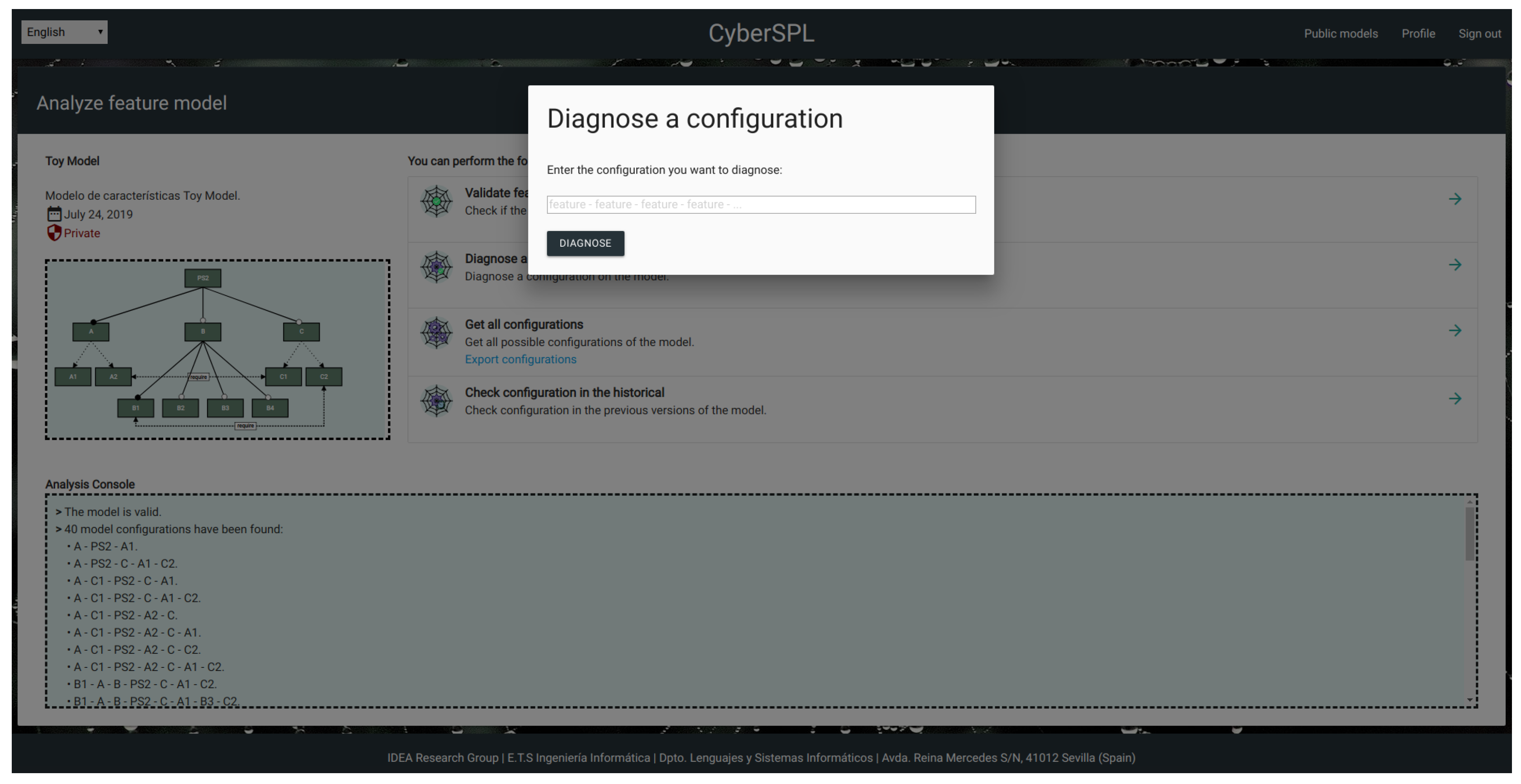
References
- Knapp, E. Chapter 11—Common Pitfalls and Mistakes. In Industrial Network Security; Syngress: Amsterdam, The Netherlands, 2011; pp. 303–312. ISBN 9781597496452. [Google Scholar]
- Martínez, S.; Cosentino, V.; Cabot, J. Model-based analysis of Java EE web security misconfigurations. Comput. Lang. Syst. Struct. 2017, 49, 36–61. [Google Scholar] [CrossRef][Green Version]
- Fernández-Cerero, D.; Varela-Vaca, Á.J.; Fernández-Montes, A.; Gómez-López, M.T.; Alvárez-Bermejo, J.A. Measuring data-centre workflows complexity through process mining: The Google cluster case. J. Supercomput. 2019. [Google Scholar] [CrossRef]
- Bai, X.; Xing, L.; Zhang, N.; Wang, X.; Liao, X.; Li, T.; Hu, S. Apple ZeroConf Holes: How Hackers Can Steal iPhone Photos. IEEE Secur. Priv. 2017, 15, 42–49. [Google Scholar] [CrossRef]
- Alfaro, J.G.; Boulahia-Cuppens, N.; Cuppens, F. Complete analysis of configuration rules to guarantee reliable network security policies. Int. J. Inf. Secur. 2008, 7, 103–122. [Google Scholar] [CrossRef]
- Lallie, H.S.; Debattista, K.; Bal, J. Evaluating practitioner cyber-security attack graph configuration preferences. Comput. Secur. 2018, 79, 117–131. [Google Scholar] [CrossRef]
- Li, X.; Xue, Y. A survey on server-side approaches to securing web applications. ACM Comput. Surv. 2014, 46, 29. [Google Scholar] [CrossRef]
- OWASP Top Ten Project. OWASP. Available online: https://www.owasp.org/index.php/Category:OWASP_Top_Ten_Project#Users_and_Adopters (accessed on 25 September 2019).
- Lotufo, R.; She, S.; Berger, T.; Czarnecki, K.; Wąsowski, A. Evolution of the Linux Kernel Variability Model. In Software Product Lines: Going Beyond; Springer: Berlin/Heidelberg, Germany, 2010; pp. 136–150. [Google Scholar]
- Kyo, K.; Sholom, C.; James, H.; William, N.; Peterson, A. Feature-Oriented Domain Analysis (FODA) Feasibility Study; Technical Report CMU/SEI-90-TR-021; Carnegie Mellon University: Pittsburgh, PA, USA, 1990. [Google Scholar]
- Batory, D. Feature Models, Grammars, and Propositional Formulas. In Software Product Lines; Springer: Berlin/Heidelberg, Germany, 2005; pp. 7–20. [Google Scholar]
- Software Product Line; Carnegie Mellon Software Engineering Institute: Pittsburgh, PA, USA; Available online: https://resources.sei.cmu.edu/library/index.cfm?fp=sei_topic:Software+Product+Lines&global=true (accessed on 6 December 2019).
- Sisiaridis, D.; Markowitch, O. Automating Feature Extraction and Feature Selection in Big Data Security Analytics. In Artificial Intelligence and Soft Computing; Springer International Publishing: Berlin/Heidelberg, Germany, 2018; pp. 423–432. [Google Scholar]
- Costa, G.; Merlo, A.; Verderame, L.; Armando, A. Automatic security verification of mobile app configurations. Future Gener. Comput. Syst. 2018, 80, 519–536. [Google Scholar] [CrossRef]
- Behringer, B.; Lehser, M.; Rothkugel, S. Towards Feature-Oriented Fault Tree Analysis. In Proceedings of the 38th International Computer Software and Applications Conference Workshops, Vasteras, Sweden, 21–25 July 2014. [Google Scholar]
- Varela-Vaca, A.J.; Gasca, R.M. Towards the automatic and optimal selection of risk treatments for business processes using a constraint programming approach. Inf. Softw. Technol. 2013, 55, 1948–1973. [Google Scholar] [CrossRef]
- Benavides, D.; Segura, S.; Ruiz-Cortés, A. Automated analysis of feature models 20 years later: A literature review. Inf. Syst. 2010, 35, 615–636. [Google Scholar] [CrossRef]
- Schumacher, M. Security Engineering with Patterns; Springer: Berlin/Heidelberg, Germany, 2003. [Google Scholar]
- Varela-Vaca, A.J.; Gasca, R.M. Formalization of security patterns as a means to infer security controls in business processes. Log. J. IGPL 2014, 23, 57–72. [Google Scholar] [CrossRef]
- Peffers, K.; Rothenberger, M.A.; Kuechler, W.L. Design Science Research in Information Systems. In Proceedings of the 7th International Conference, (DESRIST), Las Vegas, NV, USA, 14–15 May 2012. [Google Scholar]
- vom Brocke, J.; Braccini, A.M.; Sonnenberg, C.; Spagnoletti, P. Living IT infrastructures—An ontology-based approach to aligning IT infrastructure capacity and business needs. Int. J. Account. Inf. Syst. 2013, 15, 246–274. [Google Scholar] [CrossRef]
- Varela-Vaca, A.J.; Gasca, R.M.; Ceballos, R.; Bernáldez-Torres, P. CyberSPL: Plataforma para la verificación del cumplimiento de políticas de ciberseguridad en configuraciones de sistemas usando modelos de características. In Proceedings of the Actas de las V Jornadas Nacionales de Investigación en Ciberseguridad (JNIC 2019), Extremadura, Spain, 5–7 June 2019. [Google Scholar]
- Varela-Vaca, A.J.; Galindo, J.A.; Ramos-Gutiérrez, B.; Gómez-López, M.T.; Benavides, D. Process Mining to Unleash Variability Management: Discovering Configuration Workflows Using Logs. In Proceedings of the 23rd International Systems and Software Product Line Conference—Volume A (SPLC ’19), Paris, France, 9–13 September 2019. [Google Scholar]
- Galindo, J.A.; Benavides, D.; Trinidad, P.; Gutiérrez-Fernández, A.-M.; Ruiz-Cortés, A. Automated analysis of feature models: Quo vadis? Computing 2018, 101, 387–433. [Google Scholar] [CrossRef]
- Benavides, D.; Galindo, J.A. Automated analysis of feature models. In Proceedings of the 22nd International Conference on Systems and Software Product Line-SPLC ’18, Gothenburg, Sweden, 10–14 September 2018. [Google Scholar]
- Trinidad, P.; Benavides, D.; Durán, A.; Ruiz-Cortés, A.; Toro, M. Automated error analysis for the agilization of feature modeling. J. Syst. Softw. 2008, 81, 883–896. [Google Scholar] [CrossRef]
- Felfernig, A.; David, R.W.A.G.; Seda, B.; Erdeniz, P.; Atas, M.; Reiterer, S. Anytime diagnosis for reconfiguration. J. Intell. Inf. Syst. 2018, 51, 161–182. [Google Scholar] [CrossRef]
- Semmak, F.; Gnaho, C.; Laleau, R. Extended KAOS Method to Model Variability in Requirements. In Communications in Computer and Information Science; Springer: Berlin/Heidelberg, Germany, 2010; pp. 193–205. [Google Scholar]
- Pérez, J.; Laguna, M.A.; González-Carvajal, Y.C.; González-Baixauli, B. Requirements Variability Support Through MDA™ and Graph Transformation. Electron. Notes Theor. Comput. Sci. 2006, 152, 161–173. [Google Scholar] [CrossRef]
- Sawyer, P.; Mazo, R.; Diaz, D.; Salinesi, C.; Hughes, D. Using Constraint Programming to Manage Configurations in Self-Adaptive Systems. Computer 2012, 45, 56–63. [Google Scholar] [CrossRef]
- Mellado, D.; Fernández-Medina, E.; Piattini, M. Towards Security Requirements Management for Software Product Lines: A Security Domain Requirements Engineering Process. Comput. Stand. Interfaces 2008, 30, 361–371. [Google Scholar] [CrossRef]
- Mellado, D.; Fernández-Medina, E.; Piattini, M. Security Requirements Management in Software Product Line Engineering. In Proceedings of the International Conference, ICETE 2008, Porto, Portugal, 26–29 July 2008. [Google Scholar]
- Mellado, D.; Mouratidis, H.; Fernández-Medina, E. Secure Tropos Framework for Software Product Lines Requirements Engineering. Comput. Stand. Interfaces 2014, 36, 711–722. [Google Scholar] [CrossRef]
- Sion, L.; Landuyt, D.; Yskout, K.; Joosen, W. Towards systematically addressing security variability in software product lines. In Proceedings of the 20th International Systems and Software Product Line Conference, Beijing, China, 16–23 September 2016; pp. 342–343. [Google Scholar]
- Fagri, T.; Hallsteinsen, S. A Software Product Line Reference Architecture for Security. In Software Product Lines: Research Issues in Engineering and Management; Springer: Berlin/Heidelberg, Germany, 2006; pp. 275–326. [Google Scholar]
- Arciniegas, J.; Dueñas, J.; Ruiz, J.; Cerón, R.; Bermejo, J.; Oltra, M. Architecture Reasoning for Supporting Product Line Evolution: An Example on Security. In Software Product Lines: Research Issues in Engineering and Management; Springer: Berlin/Heidelberg, Germany, 2006; pp. 327–372. [Google Scholar]
- Peldszus, S.; Strüber, D.; Jürjens, J. Model-Based Security Analysis of Feature-Oriented Software Product Lines. In Proceedings of the 17th International Conference on Generative Programming: Concepts and Experiences (GPCE ’18) ACM SIGPLAN, Boston, MA, USA, 5–6 November 2018. [Google Scholar]
- Mauro, M.D.; Sarno, C.D. Improving SIEM capabilities through an enhanced probe for encrypted Skype traffic detection. J. Inf. Secur. Appl. 2018, 38, 85–95. [Google Scholar] [CrossRef]
- Zolanvari, M.; Teixeira, M.A.; Gupta, L.; Khan, K.M.; Jain, R. Machine Learning-Based Network Vulnerability Analysis of Industrial Internet of Things. IEEE Internet Things J. 2019, 6, 6822–6834. [Google Scholar] [CrossRef]
- Mellado, D.; Fernández-Medina, E.; Piattini, M. Security requirements engineering framework for software product lines. Inf. Softw. Technol. 2010, 52, 1094–1117. [Google Scholar] [CrossRef]
- Mohsin, M.; Anwar, Z.; Zaman, F.; Al-Shaer, E. IoTChecker: A data-driven framework for security analytics of Internet of Things configurations. Comput. Secur. 2017, 70, 199–223. [Google Scholar] [CrossRef]
- Acher, M.; Collet, P.; Lahire, P.; France, R.B. FAMILIAR: A domain-specific language for large scale management of feature models. Sci. Comput. Program. 2013, 6, 657–681. [Google Scholar] [CrossRef]
- Gears. Available online: https://biglever.com/solution/gears/ (accessed on 6 December 2019).
- Apel, S.; Leich, T.; Rosenmüller, M.; Saake, G. FeatureC++: On the Symbiosis of Feature-Oriented and Aspect-Oriented Programming. In Generative Programming and Component Engineering; Glück, R., Lowry, M., Eds.; Springer: Berlin/Heidelberg, Germany, 2005; pp. 125–140. [Google Scholar]
- pure::variants. Available online: https://www.pure-systems.com/ (accessed on 6 December 2019).
- Mendonca, M.; Branco, M.; Cowan, D. S.P.L.O.T.: SoftwareProduct Lines Online Tools. In Proceedings of the 24th ACM SIGPLAN ConferenceCompanion on Object Oriented Programming Systems Languages and Applications(OOPSLA ’09), Orlando, FL, USA, 25–29 October 2009; pp. 761–762. [Google Scholar]
- Mazo, R.; Muñoz-Fernández, J.C.; Rincón, L.; Salinesi, C.; Tamura, G. VariaMos: An extensible tool for engineering (dynamic) product lines. In Proceedings of the 19th International Conference on Software Product Line, SPLC 2015, Nashville, TN, USA, 20–24 July 2015; pp. 374–379. [Google Scholar]
- Anna, S.; Christian, B.; Georg, R. Glencoe: A Toolfor Specification, Visualization and Formal Analysis of Product Lines. In Transdisciplinary Engineering Methods for Social Innovation of Industry 4.0; IOS Press: Amsterdam, The Netherlands, 2018; pp. 665–673. [Google Scholar]
- Benavides, D.; Trinidad, P.; Cortés, A.R.; Segura, S. FaMa; Springer: Berlin/Heidelberg, Germany, 2013. [Google Scholar]
- Constraint Processing. 2003. Available online: https://doi.org/10.1016/b978-1-55860-890-0.x5000-2 (accessed on 6 December 2019).
- Cook, S.A. The complexity of theorem-proving procedures. In Proceedings of the Third Annual ACM Symposium on Theory of Computing-STOC ’71, Shaker Heights, OH, USA, 3–5 May 1971. [Google Scholar]
- Prud’homme, C.; Fages, J.-G.; Lorca, X. Choco Documentation. 2017. Available online: http://www.choco-solver.org (accessed on 6 December 2019).
- Hickman, K. The SSL Protocol; Netscape Communications Corp.: Dulles, VA, USA, 1995. [Google Scholar]
- Dierks, T.; Rescorla, E. The TLS Protocol Version 1.2—RFC 5246. 2008. [Google Scholar]
- Rescorla, E. The TLS Protocol Version 1.3—RFC 8446. 2018. [Google Scholar]
- Open Security Architecture. Available online: http://www.opensecurityarchitecture.org/cms/ (accessed on 6 December 2019).
- Varela-Vaca, A.J.; Parody, L.; Gasca, R.M.; Gómez-López, M.T. Automatic Verification and Diagnosis of Security Risk Assessments in Business Process Models. IEEE Access 2019, 7, 26448–26465. [Google Scholar] [CrossRef]
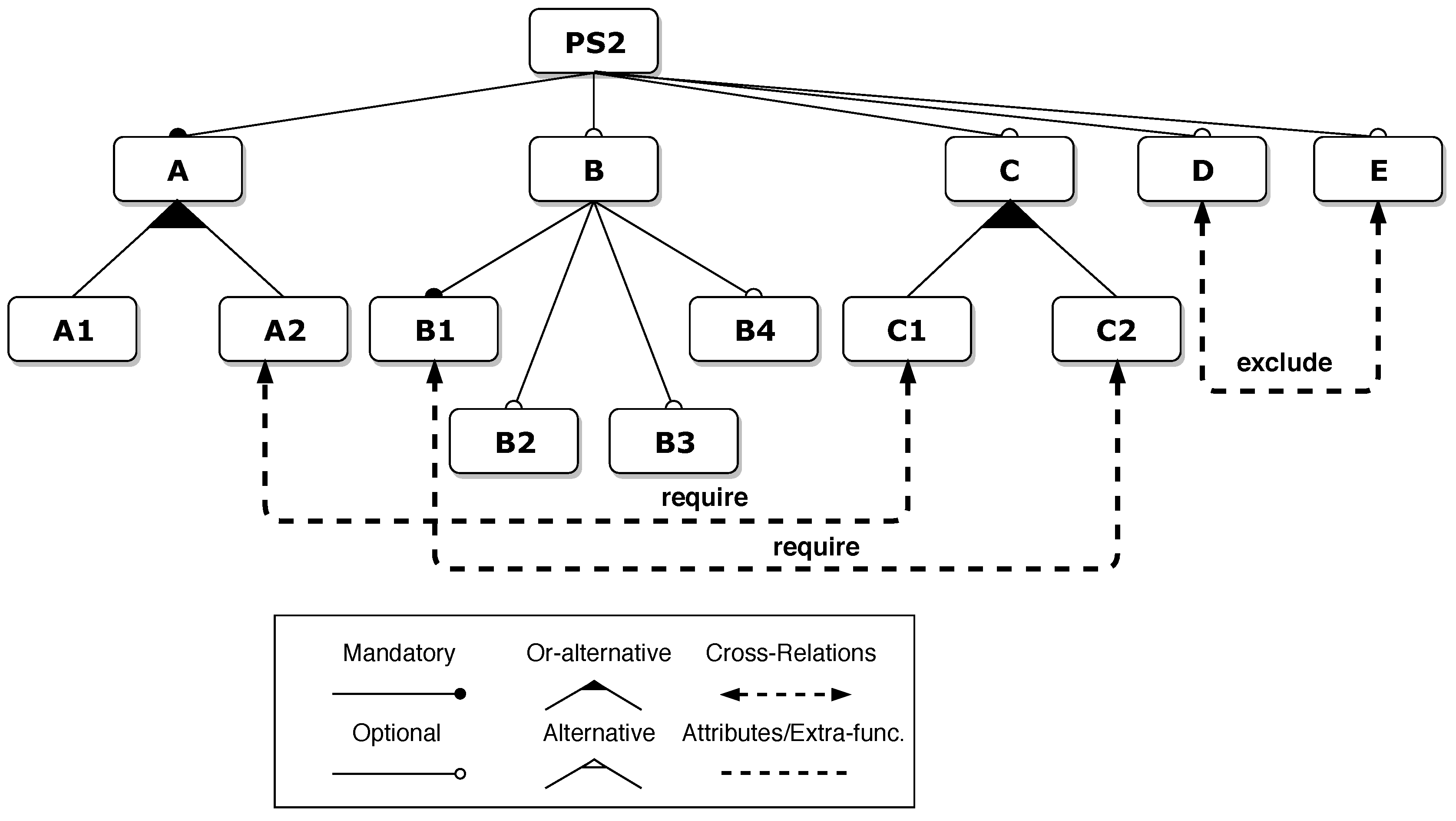
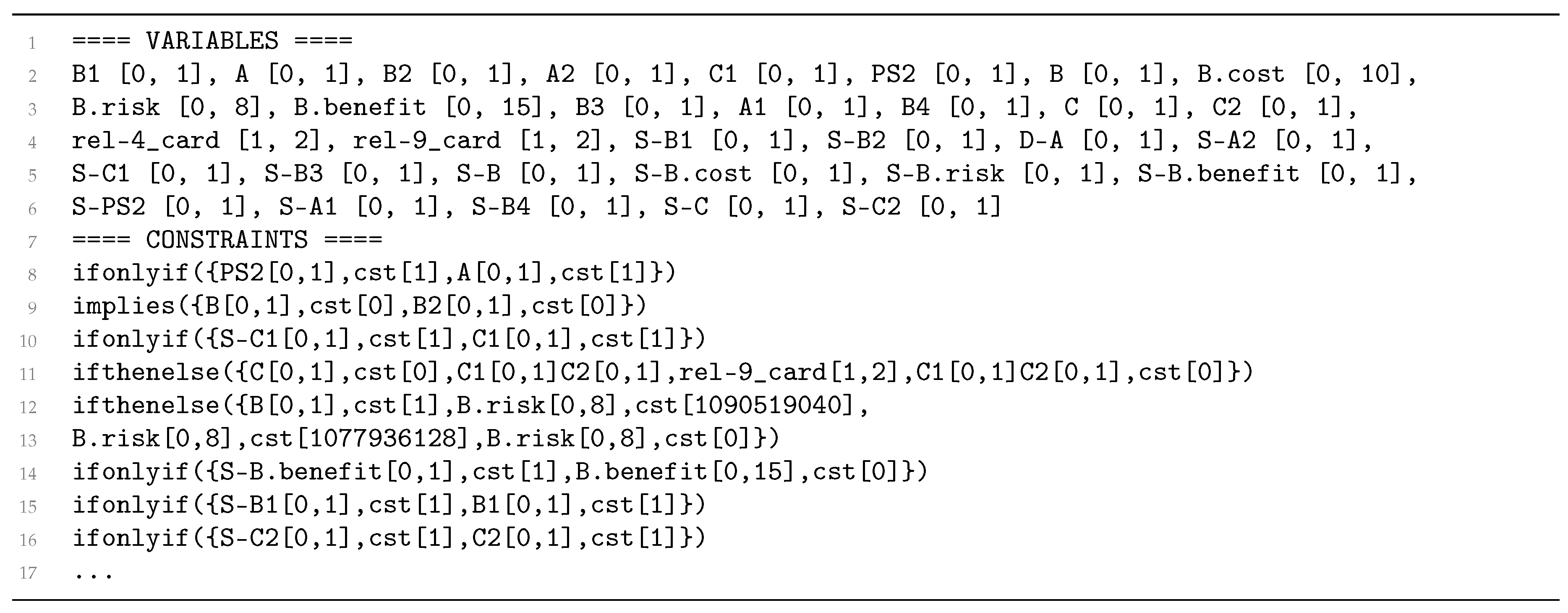



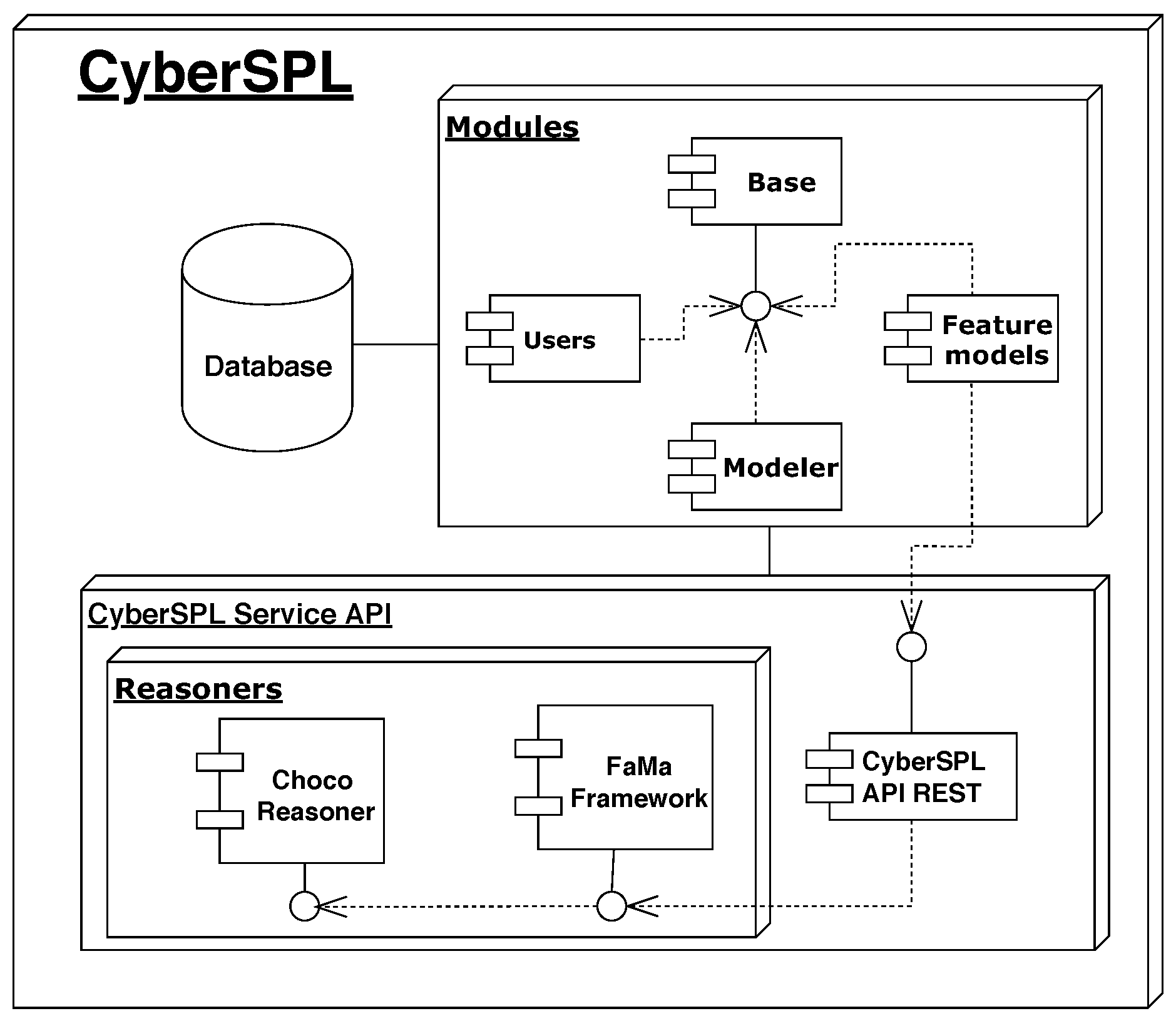
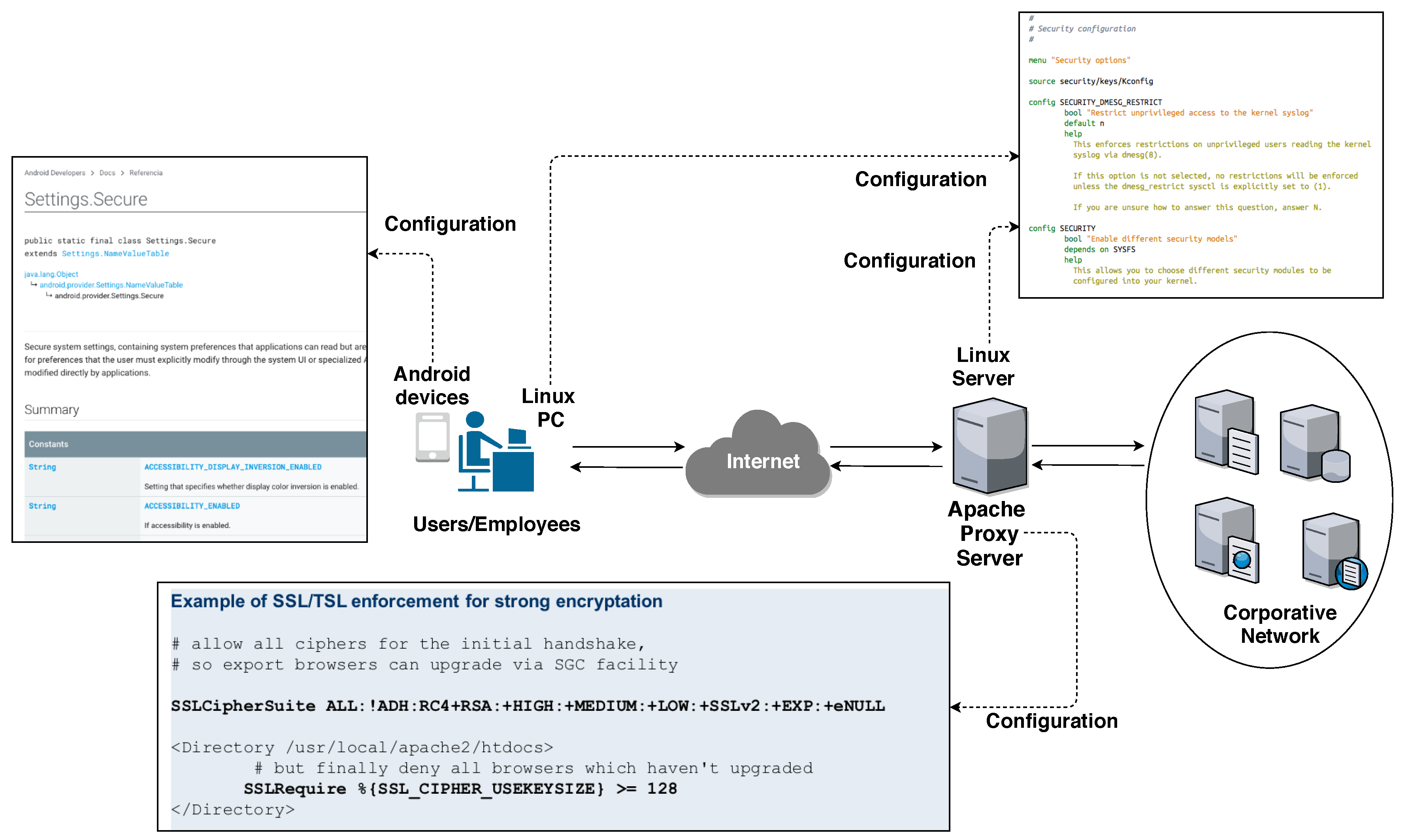





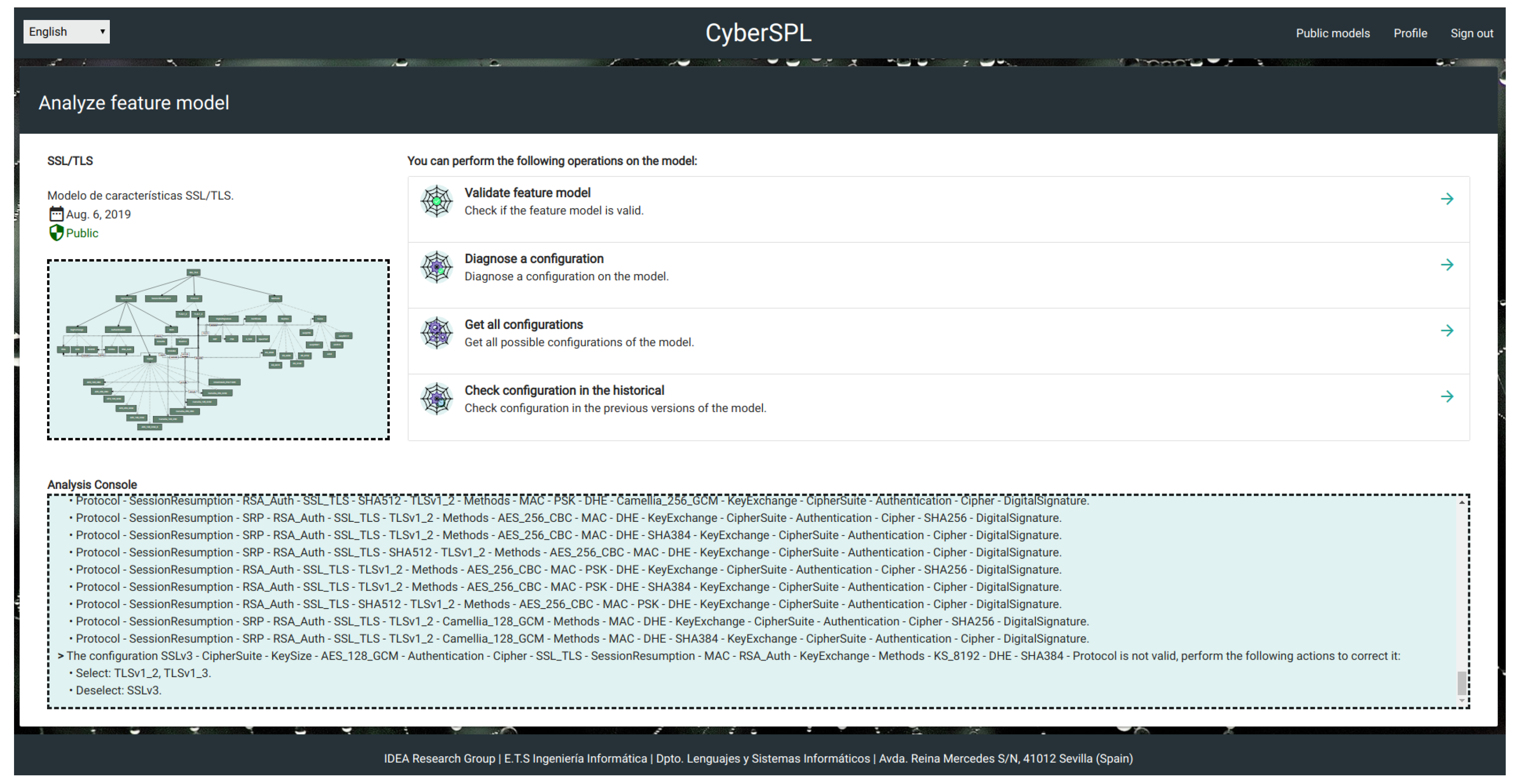
| Model Characteristics | Number of features | 12 |
| Mandatory | 2 | |
| Optional | 5 | |
| OR | 2 | |
| XOR | 0 | |
| Attributes | 1 | |
| Cross-Relations | 2 | |
| Model Analysis | Valid | ✓ |
| Number of configurations | 8 |
| Tool | Web | Diagnosis | Public Catalogue | Private Catalogue | Historical Record |
|---|---|---|---|---|---|
| CyberSPL | ✓ | ✓ | ✓ | ✓ | ✓ |
| Variamos | ✓ | ∼ | |||
| SPLOT | ✓ | ∼ | ✓ | ||
| FAMILIAR | ∼ | ||||
| FeatureIDE | ∼ | ||||
| Glencoe | ✓ | ∼ | ✓ |
| Feature Model | Apache | SSL/TLS | Android | Linux |
|---|---|---|---|---|
| Number of features | 27 | 48 | 24 | 20 |
| Mandatory | 10 | 8 | 0 | 0 |
| Optional | 3 | 0 | 5 | 18 |
| OR | 1 | 1 | 5 | 0 |
| XOR | 3 | 9 | 0 | 0 |
| Cross-Relations | 2 | 12 | 0 | 0 |
| Valid | ✓ | ✓ | ✓ | ✓ |
| Number of configurations | 576 | 1482 | 262,144 | 56,448 |
| # | Configuration | Result | Diagnosis |
|---|---|---|---|
| 1 | Apache, Protocol, TLSv1.1, KeyStore, K_File, K_Pass, K_Type, PKCS11, ClientAuth, false, Port | Valid | - |
| 2 | Apache, Protocol, TLSv1.2, KeyStore, K_File, K_Pass, K_Type, Ciphers, Algorithm, ClientAuth, want, Port, PCKS12 | Valid | - |
| 3 | Apache, Protocol, KeyStore, K_File, K_Pass, K_Type, ClientAuth, false, Port, Algorithm, Ciphers | No valid | Select: TLSv1, TLSv1.2, TLSv1.1, TLSv1.3 |
| 4 | Apache, Protocol, TLSv1.2, KeyStore, K_File, K_Pass, K_Type, ClientAuth, Port, Algorithm, Ciphers | No valid | Select: want, false |
| 5 | Apache, ClientAuth, false, Port, Keystore, K_File, K_Pass, K_Type, PKCS7, Protocol, TLSv1.3 | No valid | Select: JKS, PKCS11, PKCS12 Deselect: PKCS7 |
| 6 | Apache, Ciphers, ClientAuth, want, Keystore, K_File, K_Pass, K_Type, PKCS12, Protocol, TLSv1.3 | No valid | Select: Port |
| # | Configuration | Result | Diagnosis |
|---|---|---|---|
| 1 | SSL/TLS, Protocol, TLSv1.2, KeyExchange, DHE, CipherSuite, Cipher, AES_128_GCM, MAC, SHA256, Authentication, ECDSA, Methods, KeySize, 3072, SessionResumption | Valid | - |
| 2 | SSL/TLS, Protocol, TLSv1.2, CipherSuite, Cipher, AES_128_CCM, Authentication, ECDSA, KeyExchange, DHE, MAC, SHA512, Methods, KeySize, 3072, SessionResumption | Valid | - |
| 3 | SSL/TLSS, Protocol, TLSv1.2, CipherSuite, Cipher, AES_128_CCM, Authentication, KeyExchange, ECDHE, MAC, SHA512, Methods, KeySize, 3072, SessionResumption | No valid | Select: RSA_Auth, DHE Deselect: ECDHE |
| 4 | SSL/TLS, Protocol, CipherSuite, MAC, SHA384, Authentication, ECDSA, Cipher, AES_256_GCM, KeyExchange, DHE, Methods, KeySize, 4096, SessionResumption | No valid | Select: TLSv1.2, TLSv1.3 |
| 5 | SSL/TLS, CipherSuite, KeyExchange, SRP, Authentication, RSA_Auth, Cipher, AES_128_CCM, MAC, SHA512, SessionResumption, Protocol, TLSv1.2, Methods, KeySize, 8192 | No valid | Select: DHE Deselect: SRP |
| 6 | SSL/TLS, CipherSuite, KeyExchange, DHE, Authentication, RSA_Auth, Cipher, AES_128_CCM, MAC, SHA512, SessionResumption, Protocol, TLSv1.2, Methods, KeySize, 1024 | No valid | Select: 3072, 4096, 8192, 6149, 2048 Deselect: 1024 |
| # | Configuration | Result | Diagnosis |
|---|---|---|---|
| 1 | Linux, SECURITY, SECURITY_NETWORK, SECURITY_NETWORK_XFRM, INTEL_TXT, FORTIFY_SOURCE, STATIC_USERMODEHELPER, STATIC_USERMODEHELPER_PATH | Valid | - |
| 2 | Linux, SECURITY, SECURITY_NETWORK, SECURITY_NETWORK_XFRM, FORTIFY_SOURCE, HAVE_HARDENED_USERCOPY_ALLOCATOR, HARDENED_USERCOPY, HARDENED_USERCOPY_PAGESPAN, HARDENED_USERCOPY_FALLBACK | Valid | - |
| 3 | Linux, SECURITY, SECURITY_NETWORK_XFRM, INTEL_TXT, FORTIFY_SOURCE, STATIC_USERMODEHELPER, STATIC_USERMODEHELPER_PATH | No valid | Select: SECURITY_NETWORK Deselect: SECURITY_NETWORK_XFRM |
| 4 | Linux, SECURITY, SECURITY_NETWORK, SECURITY_NETWORK_XFRM, FORTIFY_SOURCE, HAVE_HARDENED_USERCOPY_ALLOCATOR, HARDENED_USERCOPY_FALLBACK, HARDENED_USERCOPY_PAGESPAN | No valid | Select: HARDENED_USERCOPY Deselect: HAVE_HARDENED_USERCOPY_ALLOCATOR, HARDENED_USERCOPY_FALLBACK, HARDENED_USERCOPY_PAGESPAN |
| 5 | Linux, SECURITY_DMESG_RESTRICT, INTEL_TXT, LSM, STATIC_USERMODEHELPER_PATH | No valid | Select: STATIC_USERMODEHELPER Deselect: STATIC_USERMODEHELPER_PATH |
| 6 | Linux, SECURITY_PATH, SECURITYFS, INTEL_TXT, FORTIFY_SOURCE | No valid | Select: SECURITY Deselect: SECURITY_PATH |
| # | Configuration | Result | Diagnosis |
|---|---|---|---|
| 1 | Android, ACCESSIBILITY, ACCESSIBILITY_ENABLED, ENABLED_ACCESSIBILITY_SERVICES, LOCATION, LOCATION_MODE_OFF, TTS, TTS_DEFAULT_PITCH, TTS_DEFAULT_RATE, TTS_ENABLED_PLUGINS, TTS_DEFAULT_SYNTH | Valid | - |
| 2 | Android, INPUT_METHOD, ENABLED_INPUT_METHODS, SELECTED_INPUT_METHOD_SUBTYPE, INPUT_METHOD_SELECTOR_VISIBILITY, MISCELLANEOUS, RTT_CALLING_MODE, ANDROID_ID, SKIP_FIRST_USE_HINTS, TOUCH_EXPLORATION_ENABLED | Valid | - |
| 3 | Android, ACCESSIBILITY, ACCESSIBILITY_ENABLED, ENABLED_ACCESSIBILITY_SERVICES, LOCATION_MODE_OFF, TTS, TTS_DEFAULT_PITCH, TTS_DEFAULT_RATE | No valid | Select: LOCATION Deselect: LOCATION_MODE_OFF |
| 4 | Android, INPUT_METHOD, MISCELLANEOUS, RTT_CALLING_MODE, ANDROID_ID, SKIP_FIRST_USE_HINTS, TOUCH_EXPLORATION_ENABLED | No valid | Select: DEFAULT_INPUT_METHOD, INPUT_METHOD_SELECTOR_VISIBILITY, SELECTED_INPUT_METHOD_SUBTYPE, ENABLED_INPUT_METHODS Deselect: INPUT_METHOD |
| 5 | Android, ACCESSIBILITY, ACCESSIBILITY_SPEAK_PASSWORD, LOCATION, LOCATION_MODE_OFF, INPUT_METHOD, INPUT_METHOD_SELECTOR_VISIBILITY | No valid | Select: ENABLED_ACCESSIBILITY_SERVICES, ACCESSIBILITY_DISPLAY_VERSION_ENABLED, ACCESSIBILITY_ENABLED Deselect: ACCESSIBILITY_SPEAK_PASSWORD, ACCESSIBILITY |
| 6 | Android, INPUT_METHOD, DEFAULT_INPUT_METHOD, ENABLED_INPUT_METHODS, TTS, TTS_DEFAULT_COUNTRY | No valid | Select: TTS_ENABLED_PLUGINS, TTS_DEFAULT_RATE, TTS_DEFAULT_SYNTH, TTS_DEFAULT_PITCH Deselect: TTS_DEFAULT_COUNTRY, TTS |
© 2019 by the authors. Licensee MDPI, Basel, Switzerland. This article is an open access article distributed under the terms and conditions of the Creative Commons Attribution (CC BY) license (http://creativecommons.org/licenses/by/4.0/).
Share and Cite
Varela-Vaca , Á.J.; Gasca, R.M.; Ceballos, R.; Gómez-López, M.T.; Torres, P.B. CyberSPL: A Framework for the Verification of Cybersecurity Policy Compliance of System Configurations Using Software Product Lines. Appl. Sci. 2019, 9, 5364. https://doi.org/10.3390/app9245364
Varela-Vaca ÁJ, Gasca RM, Ceballos R, Gómez-López MT, Torres PB. CyberSPL: A Framework for the Verification of Cybersecurity Policy Compliance of System Configurations Using Software Product Lines. Applied Sciences. 2019; 9(24):5364. https://doi.org/10.3390/app9245364
Chicago/Turabian StyleVarela-Vaca , Ángel Jesús, Rafael M. Gasca, Rafael Ceballos, María Teresa Gómez-López, and Pedro Bernáldez Torres. 2019. "CyberSPL: A Framework for the Verification of Cybersecurity Policy Compliance of System Configurations Using Software Product Lines" Applied Sciences 9, no. 24: 5364. https://doi.org/10.3390/app9245364
APA StyleVarela-Vaca , Á. J., Gasca, R. M., Ceballos, R., Gómez-López, M. T., & Torres, P. B. (2019). CyberSPL: A Framework for the Verification of Cybersecurity Policy Compliance of System Configurations Using Software Product Lines. Applied Sciences, 9(24), 5364. https://doi.org/10.3390/app9245364




